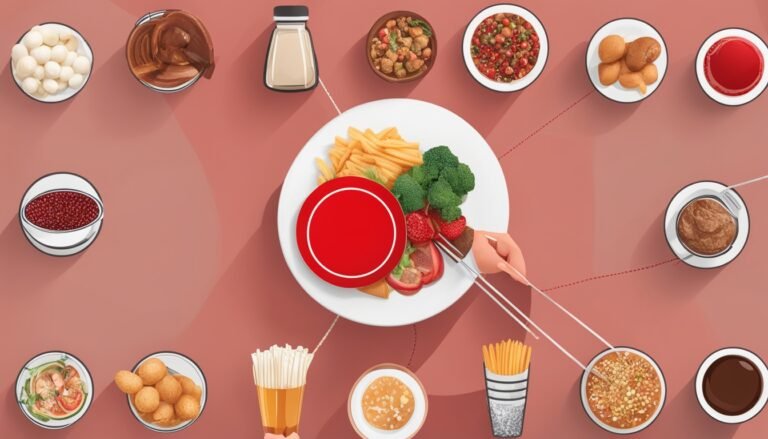How to be Thrifty?
In today’s challenging economic climate, it’s more important than ever to embrace a frugal lifestyle and maximize our resources. Being thrifty doesn’t mean depriving ourselves of joy or comfort; it means finding smart and cost-effective ways to save money without sacrificing the things that bring us happiness. In this article, I will share 11 valuable tips and strategies on how to be thrifty and take control of our financial well-being.
Key Takeaways:
- Implementing these tips can help you hold onto more cash and income.
- Creating a budget is essential for effective money management.
- Utilize coupons to enjoy discounts and maximize savings.
- Save on groceries by meal planning and reducing food waste.
- Reduce monthly bills by identifying areas where expenses can be cut.
Create a Budget
One of the most effective ways to be thrifty and manage your money effectively is by creating a budget. A budget allows you to track your income and expenses, allocate funds for savings, and make informed financial decisions. With the help of budgeting apps like Intuit Mint and YNAB, budgeting has become easier than ever.
These apps provide you with user-friendly interfaces and features that help you monitor your spending, set financial goals, and track your progress. With just a few taps on your smartphone, you can categorize your expenses, set spending limits, and receive notifications when you’re approaching your budget limits.
By using budgeting apps, you can gain a clear understanding of your financial situation and identify areas where you can cut back on expenses. This helps you make smarter money management decisions and ensure that you’re maximizing your resources and saving money.
Remember, creating a budget is not about restricting yourself; it’s about gaining control over your finances and working towards your financial goals. With the right tools and a proactive approach to money management, you can start building a solid financial foundation and enjoy the peace of mind that comes with being thrifty.
Use Coupons When You Can
When it comes to being thrifty and saving money, using coupons is a tried-and-true strategy. By taking advantage of coupons, you can enjoy significant discounts on your purchases and maximize your savings. With the digital age, coupons are easier to access than ever before. Many online platforms and apps offer a wide range of coupons for various products and services. From groceries to clothing to electronics, you can find coupons that suit your needs and help you save.
Not only do coupons help you save money, but they also allow you to try out new products or services at a reduced cost. Whether you’re looking to save on your weekly grocery bill or score a discount on a new gadget, coupons can make a significant difference in your budget. Keep an eye out for coupon codes, printable coupons, and digital coupons that can be applied at checkout. Remember to check the expiration date and any restrictions or requirements before using a coupon.
Using coupons doesn’t mean sacrificing quality or settling for less. With careful planning and strategic shopping, you can combine coupons with sales or promotions to maximize your savings. This way, you can enjoy the benefits of being thrifty without compromising on the things you love. Whether it’s a small discount or a significant amount off, every little bit adds up and contributes to your overall savings.
Table: Types of Coupons
| Type of Coupon | Description |
|---|---|
| Manufacturer Coupons | Issued by the manufacturer of a specific product and can usually be used at any store that carries the product. |
| Store Coupons | Provided by a specific store and can only be used at that particular store. |
| Online Coupons | Obtained through websites or apps and can be used for online purchases. |
| Mobile Coupons | Received on your mobile device and usually require scanning a barcode at checkout. |
| Printable Coupons | Downloaded or printed from websites and can be used at physical stores. |
| Digital Coupons | Loaded onto a store loyalty card or account and automatically applied at checkout. |
Save on Groceries
When it comes to being thrifty, one of the most effective areas to focus on is saving on groceries. By implementing a few simple strategies, you can significantly reduce your grocery expenses and maximize your savings. Let’s explore some tips on how to achieve grocery savings through meal planning, buying produce on sale or in season, and being mindful of food waste.
Meal Planning
Meal planning is a valuable tool for both saving money and ensuring you have delicious and nutritious meals throughout the week. By taking the time to plan your meals in advance, you can avoid impulse purchases and only buy the ingredients you need. This helps to minimize waste and ensures that you make the most of your grocery budget.
Consider creating a weekly meal plan and making a shopping list based on the planned meals. This way, you can shop with purpose and avoid buying unnecessary items. Additionally, planning your meals allows you to take advantage of any discounts or promotions on ingredients, further maximizing your savings.
Buy In Season and On Sale
Another effective strategy for saving on groceries is to buy produce that is in season and on sale. Seasonal fruits and vegetables are often more affordable as they are abundant and readily available. They also tend to be fresher and more flavorful. By incorporating seasonal produce into your meal planning, you can enjoy variety while keeping your grocery costs down.
Furthermore, keeping an eye out for sales and discounts can help you make significant savings on your grocery bill. Many supermarkets offer weekly specials or promotions on various products. Be sure to check store flyers or websites for the best deals before you go shopping. By planning your purchases around these sales, you can stock up on essential items at a lower cost.
Reduce Food Waste
Reducing food waste is not only good for the environment but also beneficial for your wallet. By being mindful of expiration dates and utilizing leftovers, you can avoid throwing away perfectly good food and save money in the process.
When meal planning, consider incorporating leftover ingredients into future meals to minimize waste. For example, if you have extra vegetables from one dish, you can use them in a stir-fry or a soup the following day. Additionally, properly storing and organizing your groceries can help prolong their freshness, preventing unnecessary spoilage.
By implementing these strategies, you can effectively save on groceries and maximize your overall savings. Meal planning, buying in season and on sale, and reducing food waste are all practical steps that will have a significant impact on your budget. Start incorporating these tips into your grocery shopping routine and enjoy the benefits of being thrifty.

Reduce Monthly Bills
As part of a thrifty lifestyle, it’s important to identify areas where you can cut down on expenses and save money. One effective way to achieve this is by reducing your monthly bills. By taking a closer look at your recurring expenses and finding opportunities for cost-cutting, you can significantly increase your savings and improve your financial well-being.
Identifying Areas for Cost-Cutting
To begin reducing your monthly bills, start by analyzing your expenses and identifying areas where you can make adjustments. Consider your phone and internet bills, cable or streaming subscriptions, utility costs, and insurance premiums. Look for any services or plans that you no longer need or can downgrade to a more budget-friendly option.
For example, if you find that you’re paying for a high-speed internet connection but only use it for basic browsing and streaming, consider downgrading to a more affordable plan. Similarly, review your cable or streaming subscriptions and unsubscribe from any services that you rarely use or duplicate content.
Energy-Saving Tips
An often overlooked aspect of reducing monthly bills is implementing energy-saving measures. By being mindful of your energy consumption, you can cut down on electricity costs and contribute to a more sustainable environment. Here are some tips to help you save on energy:
- Turn off lights and unplug electronics when not in use.
- Use energy-efficient light bulbs.
- Set your thermostat to an optimal temperature and consider using a programmable thermostat.
- Seal any drafts and insulate your home to minimize heat or cool air loss.
- Opt for natural light during the day and use blinds or curtains to regulate temperature.
By implementing these energy-saving practices, you can reduce your electricity usage and lower your monthly utility bills.
| Monthly Bill | Potential Savings |
|---|---|
| Phone and Internet | $30-$50 by downgrading plans or switching providers |
| Cable or Streaming Subscriptions | $10-$50 by eliminating unused or duplicate services |
| Utilities (Electricity, Water, etc.) | $10-$50 by implementing energy-saving measures |
| Insurance Premiums | Varies, but potential savings of hundreds of dollars by shopping around for better rates |
By assessing your monthly bills, implementing energy-saving practices, and making necessary adjustments, you can significantly reduce your expenses and increase your savings. Remember, every dollar saved adds up and contributes to your financial well-being.
Cancel Streaming Accounts You Don’t Use
In today’s digital age, streaming services have become increasingly popular, providing a vast array of entertainment options at our fingertips. While these services offer convenience and a wide selection of content, they can also come with a hefty price tag. To be truly thrifty, it’s important to evaluate which streaming accounts you actually use and consider canceling the ones that are no longer benefiting you.
By regularly reviewing your streaming subscriptions, you can eliminate unnecessary expenses and redirect those funds towards more meaningful purchases or savings goals. Take a look at your account history and usage patterns to determine which platforms you frequently access and enjoy. If there are accounts that have gone unused for months or even years, it might be time to say goodbye and save some money in the process.
Remember, being thrifty doesn’t mean sacrificing entertainment or missing out on your favorite shows and movies. Many streaming platforms offer free limited-access options or free trials, allowing you to explore new content without a financial commitment. Additionally, you can consider sharing a subscription with family or friends, splitting the cost and enjoying the benefits at a fraction of the price.
Benefits of Cancelling Unused Streaming Accounts:
- Cost savings on monthly subscription fees
- Reduced clutter and simplified entertainment options
- Increased mindfulness about consumption habits and expenses
- Opportunity to explore alternative free or low-cost entertainment options
- Potential for more focused and intentional viewing habits
| Streaming Service | Monthly Cost |
|---|---|
| Netflix | $12.99 |
| Hulu | $5.99 |
| Amazon Prime Video | $8.99 |
| Disney+ | $6.99 |
Table: Monthly Costs of Popular Streaming Services
Reduce How Much You Dine Out
When trying to be thrifty, one area where individuals can make a significant impact on their finances is by reducing the amount they dine out. While eating at restaurants can be a convenient and enjoyable experience, it often comes with a hefty price tag. By opting for home-cooked meals instead, you can save a considerable amount of money in the long run.
Preparing meals at home not only allows you to have full control over the ingredients and portion sizes but also provides an opportunity to bond with loved ones through shared cooking experiences. It’s a chance to explore new recipes, experiment with flavors, and enjoy the satisfaction of creating delicious meals from scratch.
Aside from the financial benefits, cooking at home also promotes healthier eating habits. You have the power to choose wholesome ingredients and control the amount of salt, sugar, and unhealthy fats in your meals. By making conscious choices and planning your meals in advance, you can nourish your body and save money at the same time.
“Cooking at home not only saves money, but it also allows you to be more mindful of what you’re putting into your body.”
Here are a few tips to help you make the most of your home-cooked meals:
- Plan your meals for the week to avoid impulse buying and reduce food waste.
- Buy ingredients in bulk to save money in the long run.
- Experiment with plant-based recipes to cut down on meat costs.
- Invest in kitchen tools that make cooking easier and more enjoyable.
- Make extra portions to pack for lunch or freeze for later, saving both time and money.
| Expense | Cost per Month |
|---|---|
| Average cost of eating out | $300 |
| Cost of home-cooked meals | $150 |
| Savings per month | $150 |

Summary
By reducing how much you dine out and embracing the joy of cooking at home, you can save money, improve your health, and create memorable moments with loved ones. Planning your meals, buying ingredients in bulk, and investing in kitchen tools are just a few strategies that can help you maximize your savings and enhance your culinary experience. So why not put on an apron, gather your favorite recipes, and start enjoying the benefits of home-cooked meals today!
Stop Paying to Work Out
When it comes to fitness, many people automatically think of expensive gym memberships and fitness classes. However, being thrifty doesn’t mean you have to sacrifice your health or fitness goals. There are plenty of ways to stay active and work out without breaking the bank. By exploring free workout options, you can save money while still getting the exercise you need.
One of the easiest ways to find free workouts is by turning to online resources. Platforms like YouTube offer a vast array of workout videos that you can follow along with from the comfort of your own home. Whether you’re into yoga, HIIT, or dance workouts, there’s something for everyone. Additionally, many fitness influencers and trainers offer free downloadable workout programs on their websites or social media channels.
If you prefer the camaraderie of exercising with others, consider joining a community group or club. Many cities have running clubs or group fitness sessions that are either free or require a minimal fee to cover basic expenses. These sessions not only provide an opportunity to work out but also allow you to meet like-minded individuals who share your fitness goals.
Working out at home is another budget-friendly option. You don’t need expensive equipment to stay active – bodyweight exercises can be just as effective. Push-ups, squats, lunges, and planks are all great exercises that require no equipment and can be done anywhere. You can also utilize household items like water bottles or cans as makeshift weights for strength training exercises. By incorporating these exercises into your routine, you can save money on gym fees and still achieve your fitness goals.
Remember, being thrifty and working out don’t have to be mutually exclusive. By exploring free workout options, you can save money while still prioritizing your health and well-being.

Table: Comparison of Exercise Options
| Exercise Option | Cost | Location |
|---|---|---|
| Traditional Gym | $$ | Indoor |
| Fitness Classes | $$ | Indoor |
| YouTube Workouts | $ | Indoor |
| Community Group | $ | Indoor/Outdoor |
| Home Workouts | $ | Indoor |
Table: Comparison of Exercise Options – Cost, Location
As you can see from the table, traditional gym memberships and fitness classes tend to be more expensive options. On the other hand, YouTube workouts, community groups, and home workouts offer more cost-effective alternatives. Depending on your preferences and budget, you can choose the option that best fits your needs. Remember, staying fit doesn’t have to mean emptying your wallet.
Buying Used: A Cost-Effective Approach
When it comes to being thrifty and saving money, one effective strategy is to buy used items. Secondhand shopping not only allows you to find quality products at a fraction of the original cost but also contributes to a more sustainable and eco-friendly lifestyle. Whether you’re looking for furniture, clothing, electronics, or other goods, buying used presents a range of benefits for both your wallet and the environment.
When you buy used, you have access to a wide variety of products at significantly reduced prices. Platforms like eBay, Craigslist, and Facebook Marketplace provide a marketplace where individuals can sell their pre-loved items, giving you the opportunity to find unique and valuable items at a fraction of the retail price. Additionally, thrift stores and consignment shops offer an array of affordable options for clothing, accessories, and household items.
By choosing to buy used, you not only save money but also contribute to reducing waste and carbon footprint. Opting for secondhand items means reducing the demand for new products, which in turn decreases the resources required for manufacturing and transportation. It’s a small but impactful way to support a more sustainable economy and protect our environment.
Benefits of Buying Used:
- Significantly reduced prices compared to new items
- Access to unique and valuable products
- Supporting a more sustainable and eco-friendly lifestyle
- Reducing waste and carbon footprint
“Buying used allows me to find amazing deals and unique items that I wouldn’t be able to afford otherwise. It’s not only a smart financial decision but also a way to contribute to a more sustainable world.” – Thrifty Shopper
| Product | New Price | Used Price | Savings |
|---|---|---|---|
| Designer Handbag | $500 | $200 | $300 |
| Smartphone | $1000 | $500 | $500 |
| Dining Table | $800 | $300 | $500 |
As shown in the table above, buying used can lead to significant savings on various products. By choosing to purchase pre-owned items, you can stretch your budget further and enjoy the same quality and functionality at a fraction of the cost. So whether you’re looking to update your wardrobe, furnish your home, or find unique treasures, consider buying used and embrace the thrifty and sustainable approach.

Share and Swap With Friends
In today’s sharing economy, embracing a culture of sharing and swapping items with friends and neighbors is not only a thrifty approach but also a way to foster community engagement. By sharing and exchanging clothing, sports equipment, furniture, and other items, you can fulfill your needs without spending additional money. This also promotes sustainability, reduces waste, and strengthens social connections.
Engaging in item swapping allows you to access a variety of items that you may not have otherwise been able to afford or justify purchasing. Whether it’s borrowing a lawnmower from a neighbor, borrowing a dress for a special occasion, or exchanging books with friends, sharing resources within your community can save you money while encouraging a sense of camaraderie.
The benefits of sharing and swapping extend beyond financial savings. These interactions build stronger relationships within your community and provide opportunities for meaningful connections. Engaging with others through sharing promotes a sense of trust, empathy, and reciprocity, creating a supportive network that goes beyond material possessions. So, next time you need something, consider reaching out to your friends and neighbors and explore the possibilities of sharing and swapping.
Benefits of Sharing and Swapping:
- Cost savings: Access items without purchasing them
- Sustainability: Reduce waste and promote a circular economy
- Community engagement: Foster social connections and build relationships
- Resource maximization: Utilize resources more efficiently within your community
- Variety and flexibility: Access a wide range of items that you may not have otherwise had
Look for Cash Back Rewards
When it comes to being thrifty and saving money, every little bit helps. One strategy that can add up to significant savings is taking advantage of cash back rewards. Many credit card companies offer cash back programs that allow you to earn a percentage of your purchases back as a reward. By using cash-back credit cards and participating in rewards programs, you can earn money on your everyday expenses and make your money work for you.
One of the great things about cash back rewards is that they can be redeemed in a variety of ways. Some credit cards offer statement credits, which can be applied directly to your balance and help reduce your overall debt. Other cards allow you to redeem your rewards as a deposit into a savings account or as a gift card to your favorite store. This flexibility gives you the freedom to choose how you want to use your rewards and maximize your savings.
“Using cash back rewards has allowed me to save hundreds of dollars each year. It’s like getting paid just for making my regular purchases!” – Jane M.
To make the most of cash back rewards, it’s important to choose the right credit card and understand the terms and conditions. Look for a card that offers a competitive cash back rate on the types of purchases you make most frequently. Some cards even have rotating categories that allow you to earn higher cash back percentages during certain times of the year. Additionally, be mindful of any annual fees or interest rates associated with the card to ensure that the rewards outweigh the costs.
By incorporating cash back rewards into your financial strategy, you can earn some extra money while sticking to your thrifty lifestyle. Whether it’s putting the cash back towards your savings goals or treating yourself to something special, these rewards can make a real difference in your financial well-being.
| Card Name | Cash Back Rate | Annual Fee |
|---|---|---|
| Card A | 2% | $0 |
| Card B | 1.5% | $50 |
| Card C | 3% (rotating categories) | $0 |
Conclusion
Embracing a thrifty lifestyle is the key to achieving financial independence and mastering money-saving strategies. By following the tips and strategies outlined in this article, I have discovered the power of managing my finances wisely and maximizing every dollar. Being thrifty doesn’t mean depriving myself of joy or comfort; it means making smart choices that align with my financial goals.
Through creating a budget, using coupons, and cutting down on unnecessary expenses, I have been able to save more money than I ever thought possible. By implementing meal planning and reducing my dining out habits, my grocery bill has significantly decreased without sacrificing delicious and nutritious meals.
Additionally, I’ve realized the value of buying used items and sharing with friends, not only for my wallet but also for the environment and community. Exploring free workout options and seeking cash back rewards have allowed me to stay fit and earn extra savings effortlessly.
Incorporating these thrifty practices into my everyday life has empowered me to take control of my finances and work towards financial independence. It’s amazing how small changes can make a big impact over time. By adopting a thrifty mindset and embracing these money-saving strategies, I am confidently paving my way towards a brighter and more secure financial future.
FAQ
How can I be thrifty?
Being thrifty means managing your money effectively and saving where you can. It involves budgeting, using coupons, reducing expenses, and making smart financial decisions.
What is the first step to being thrifty?
Setting a budget is a key step in being thrifty. By creating a budget, you can track your income and expenses, allocate funds for savings, and make informed financial decisions.
How can I save money on groceries?
You can save on groceries by implementing strategies such as meal planning, buying produce on sale or in season, opting for generic brands, and avoiding food waste.
How can I reduce my monthly bills?
You can reduce monthly bills by identifying areas where expenses can be reduced, such as high phone or internet bills, being mindful of energy usage, and avoiding unnecessary electricity wastage.
What should I do with streaming accounts I no longer use?
Being thrifty means canceling unused streaming accounts to avoid unnecessary expenses. Regularly reviewing and assessing your subscriptions will help you eliminate any accounts you don’t actively utilize.
How can I save money on dining out?
Being thrifty involves reducing the frequency of eating meals at restaurants and opting for home-cooked meals instead. By preparing meals at home, you can save money and have the opportunity to bond with loved ones through shared cooking experiences.
How can I work out without paying for gym memberships?
Being thrifty means finding alternative ways to exercise without incurring costly gym memberships or fitness classes. You can explore free workout options such as YouTube videos, community yoga classes, or group running sessions.
How can I buy items at a lower cost?
Buying used items is not only thrifty but also environmentally friendly. Consider purchasing used items from platforms like eBay, Craigslist, or Facebook Marketplace. Thrift stores and consignment stores also offer excellent opportunities to find quality items at a fraction of the original cost.
How can I save money by sharing and swapping items?
Sharing and swapping items with friends and neighbors is a great way to be thrifty. By exchanging clothing, sports equipment, furniture, and other items, you can fulfill your needs without spending additional money. This promotes community engagement and fosters relationships among individuals.
How can I benefit from cash-back rewards?
Cash-back rewards can add up and contribute to significant savings. By utilizing reliable cash-back credit cards with easy redemption options, you can earn rewards on your purchases. These rewards can then be used to pay off credit card bills or contribute to savings accounts.






